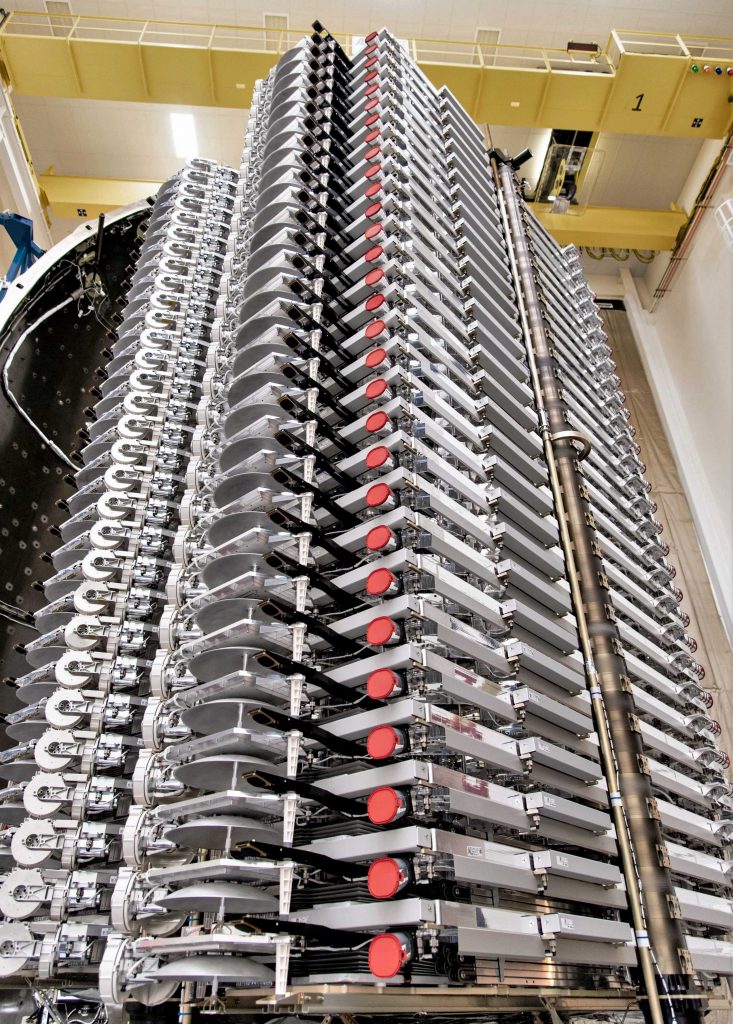SpaceX has successfully fired up a Falcon 9 rocket for the first time in 2020, setting the company up for the first of potentially dozens of Starlink launches over the next 12 months.
On the afternoon of January 4th, SpaceX loaded Falcon 9 with hundreds of tons of liquid oxygen, refined kerosene (RP-1), nitrogen, and helium and ultimately ignited all nine of the booster’s Merlin 1D engines, briefly producing some 7600 kN (1.7 million lbf) of thrust in a routine test known as a wet dress rehearsal (WDR) and static fire. As is tradition, SpaceX confirmed that the test looked successful just a handful of minutes after it was completed and verified that the rocket is now scheduled to launch 60 new Starlink satellites as early as 9:19 pm ET, January 6th (02:19 UTC, Jan 7).
Set to lift off from its LC-40 Cape Canaveral Air Force Station (CCAFS) launch pad, SpaceX’s first launch of the new year and decade hints at what is expected to follow over the course of 2020. In simple terms, the company’s ambitions have never been higher and anywhere from 36 to 38 orbital launches are scheduled between now and 2021 – some 65% of which will likely be internal Starlink missions.
If SpaceX manages to launch even half as many Starlink missions as it says it wants to this year, the company will be heading into 2021 with an operational internet satellite constellation nearly a thousand spacecraft strong – almost enough to ensure uninterrupted global coverage. Already, if SpaceX’s January 6th launch – known as Starlink V1 L2 (the second launch of v1.0 satellites) – goes as planned, the company will almost certainly become the owner of the world’s largest commercial satellite constellation less than eight months after it began launching its unique flat-packed spacecraft.

In a classic SpaceX move, the company’s Starlink satellite bus is a radical departure from all other commercial spacecraft, opting for a table-like rectangular shape that is extremely flat. While the rectangular shape – likely chosen for the extreme ease of manufacturing it should allow – significantly decreases packing efficiency, Starlink’s flat design and unique deployment mechanism means that SpaceX can fit an unprecedented 60 satellites (each weighing more than 250 kg or 550 lb) into a single lightly-modified Falcon 9 payload fairing.
Ultimately, SpaceX also design its Starlink satellites to be dramatically more robust than any comparable commercial spacecraft, meaning that they are meant to tolerate the violent acoustic launch environment without foam sound suppression panels that otherwise take up space inside Falcon 9’s fairing. Additionally, they are meant to survive the odd collision during their bizarre deployment, in which Falcon 9’s upper stage spins itself like a fan and releases the entire 60-satellite stack at once. Further, this means that Starlink satellites can be transported from their Washington state factory to Cape Canaveral, Florida far more easily and cheaply than almost any other spacecraft of a similar size and weight.
Falcon 9’s second fourth flight
It’s a mouthful, but SpaceX’s Starlink-2 mission will technically mark Falcon 9’s second fourth flight, meaning that it will be the second time a single Falcon 9 booster launches (and optimally lands) for the fourth time. Thrice-flown Falcon 9 booster B1049 has been assigned to support the launch.
The fourth completed Falcon 9 Block 5 booster, B1049 debuted on September 10th, 2018 on the Telstar 18V satellite launch, followed by a second flight (Iridium-8) in January 2019 and its third and most recent launch in May 2019. B1049’s most recent mission happened to be the very first dedicated Starlink launch, placing 60 Starlink v0.9 spacecraft in orbit in a sort of massive beta test of SpaceX’s cutting-edge satellite technology and design.
In support of Starlink V1 L1, the first launch of finalized Starlink v1.0 satellites, Falcon 9 booster B1048 became the first SpaceX rocket to successfully launch and land four times in November 2019, safely returning to shore aboard drone ship Of Course I Still Love You (OCISLY) a few days later. With (hopefully) two (and soon three) recovered boosters with four flights each under their belts, SpaceX will have a relative wealth of data it can then use to plot the way forward to fifth flights of boosters and beyond – halfway to the minimum Block 5 design goal of 10 launches apiece.
Teslarati photographer Richard Angle (@RDanglePhoto) will be on-site to capture SpaceX’s first Falcon 9 launch and booster recovery of the 2020s. Stay tuned for more details and photos as the launch nears!
Check out Teslarati’s newsletters for prompt updates, on-the-ground perspectives, and unique glimpses of SpaceX’s rocket launch and recovery processes.

(adsbygoogle = window.adsbygoogle || []).push({});
<!–
–>
var disqus_shortname = «teslarati»;
var disqus_title = «SpaceX Falcon 9 rocket tests engines for first launch and landing of the new decade»;
var disqus_url = «https://www.teslarati.com/spacex-falcon-9-rocket-first-launch-landing-2020/»;
var disqus_identifier = «teslarati-125505»;

